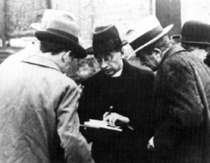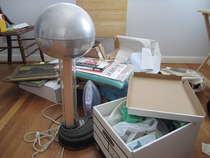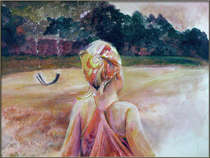 News stations have a countdown clock ticking off minutes as the deadline to raise the United States debt ceiling approaches. Tuesday is the day, and many Americans are watching to see what will happen. Will the US default on its debts? Will our representatives and senators be able to transcend their philosophical differences and compromise?
News stations have a countdown clock ticking off minutes as the deadline to raise the United States debt ceiling approaches. Tuesday is the day, and many Americans are watching to see what will happen. Will the US default on its debts? Will our representatives and senators be able to transcend their philosophical differences and compromise?
Jim Wallis of Sojourners suggests that someone other than politicians, the American public, and financial experts around the world are watching the process: God is watching, too.
Read his blog God Is Watching; it expresses my feelings and those of many around the world. I cannot understand a political philosophy that is comfortable with keeping tax loopholes for huge corporations and tax cuts for the richest Americans while proposing huge cuts in Social Security and Medicare as well as funding cuts for numerous social services and education.
When push comes to shove, Jesus sides with the poor and those on the fringes of society. We are told to care for the poor, widows, and orphans. I pray for wisdom for our government leaders, for compassionate hearts. A phone call our senators and representatives might help. (Find yours here: Senators; House of Representatives)
The countdown clock is ticking.
 Portrait by Berthold Pluum He was listed under “Other Saints” on the
Portrait by Berthold Pluum He was listed under “Other Saints” on the  Not many years after returning home, Titus along with the rest of the Dutch people began suffering under the invasion of the Nazis. In both his writing and preaching, Titus refused to follow their directives. When the Dutch Church decided to instruct the editors of all its newspapers and magazines to refuse to publish Nazi articles and propaganda, Titus insisted on informing each editor and staff himself.
Not many years after returning home, Titus along with the rest of the Dutch people began suffering under the invasion of the Nazis. In both his writing and preaching, Titus refused to follow their directives. When the Dutch Church decided to instruct the editors of all its newspapers and magazines to refuse to publish Nazi articles and propaganda, Titus insisted on informing each editor and staff himself.  This blog is named after the symbol for pilgrimage that had its beginnings with the great pilgrimage to the cathedral of Santiago de Compestela in Galicia in Northwest Spain: The scallop shell. The connection of this shell with pilgrimage is rooted in both use and legend.
This blog is named after the symbol for pilgrimage that had its beginnings with the great pilgrimage to the cathedral of Santiago de Compestela in Galicia in Northwest Spain: The scallop shell. The connection of this shell with pilgrimage is rooted in both use and legend. 
 I arrived at the airport in plenty of time. My flight was delayed, enabling me to grab a quick breakfast. While waiting for the food to arrive, I decided to check out my cell phone. It had to be SOMEWHERE in my black carry on, I told myself as I rummaged through it. No luck.
I arrived at the airport in plenty of time. My flight was delayed, enabling me to grab a quick breakfast. While waiting for the food to arrive, I decided to check out my cell phone. It had to be SOMEWHERE in my black carry on, I told myself as I rummaged through it. No luck.  This sonogram was shared by a friend whose daughter is expecting her first child. The baby in the picture is about the size of a quarter. Amazing, both the detail of the sonogram and the clearly developed features of the tiny baby.
This sonogram was shared by a friend whose daughter is expecting her first child. The baby in the picture is about the size of a quarter. Amazing, both the detail of the sonogram and the clearly developed features of the tiny baby. 
 PHOTO: Mary van Balen Here is my kitchen counter, built by my brother, brightened with flowers from my sister, dish towels from my cousin in the Netherlands, and the framed print from my student. Little reminders of people and places, of love and support. Last night, my daughter lent me a cable to upload the photos from my camera. I trust my cable will show up as boxes are emptied.
PHOTO: Mary van Balen Here is my kitchen counter, built by my brother, brightened with flowers from my sister, dish towels from my cousin in the Netherlands, and the framed print from my student. Little reminders of people and places, of love and support. Last night, my daughter lent me a cable to upload the photos from my camera. I trust my cable will show up as boxes are emptied. A good thing about moving a number of times in the past few years is the opportunity to realize how little I really need to run a home. So, as I empty boxes I fill others with donations for Good Will or St. Vincent’s. One thing I will keep though, impractical as it is, is the van der Graff machine. If nothing else it’s a great conversation starter and on dry days, it makes your hair stand on end!
A good thing about moving a number of times in the past few years is the opportunity to realize how little I really need to run a home. So, as I empty boxes I fill others with donations for Good Will or St. Vincent’s. One thing I will keep though, impractical as it is, is the van der Graff machine. If nothing else it’s a great conversation starter and on dry days, it makes your hair stand on end!  Please excuse the long gap between blog posts. I have been moving and though progress has been made, boxes abound and my office looks as if its contents were dropped into place by a windstorm. I took a few photos to use today, but can’t find the little usb cable I need to connectcamera to computer. Thus the clip art!
Please excuse the long gap between blog posts. I have been moving and though progress has been made, boxes abound and my office looks as if its contents were dropped into place by a windstorm. I took a few photos to use today, but can’t find the little usb cable I need to connectcamera to computer. Thus the clip art! PHOTO: Mary van Balen Lord, it is night. The night is for stillness. Let us be still in the presence of God. It is night after a long day. What has been done has been done; what has not been done has not been done; let it be…
PHOTO: Mary van Balen Lord, it is night. The night is for stillness. Let us be still in the presence of God. It is night after a long day. What has been done has been done; what has not been done has not been done; let it be…

 They elicit smiles, laughter, tears, and questions. They grapple with big questions, enter into mystery’s darkness, and plumb the soul’s depths. Then they share what they have found with any who will listen. They do these things because they must. Money or not, success or not, being an artist is not something one does, it is who one is.
They elicit smiles, laughter, tears, and questions. They grapple with big questions, enter into mystery’s darkness, and plumb the soul’s depths. Then they share what they have found with any who will listen. They do these things because they must. Money or not, success or not, being an artist is not something one does, it is who one is.